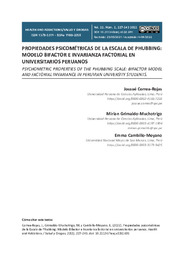Por favor, use este identificador para citar o enlazar este ítem:
https://hdl.handle.net/11000/29326Registro completo de metadatos
| Campo DC | Valor | Lengua/Idioma |
|---|---|---|
| dc.contributor.author | Correa-Rojas, Jossué | - |
| dc.contributor.author | Grimaldo-Muchotrigo, Mirian | - |
| dc.contributor.author | Cambillo-Moyano, Emma | - |
| dc.contributor.other | Departamentos de la UMH::Psicología de la Salud | es_ES |
| dc.date.accessioned | 2023-07-03T08:04:35Z | - |
| dc.date.available | 2023-07-03T08:04:35Z | - |
| dc.date.created | 2022 | - |
| dc.identifier.citation | Health and Addictions / Salud y Drogas, 22(2) | es_ES |
| dc.identifier.issn | 1988-205X | - |
| dc.identifier.uri | https://hdl.handle.net/11000/29326 | - |
| dc.description.abstract | Introducción: El Phubbing es una conducta que consiste en menospreciar la comunicación interpersonal directa por dar preferencia al uso del teléfono inteligente, por su naturaleza descalificadora tiene implicancias negativas en la vida de las personas. La Escala de Phubbing es la medida más utilizada para medir este atributo, fue diseñada por Karadag et al. (2015) y ha demostrado sostener su estructura bidimensional en diferentes contextos. Objetivo: El presente estudio se concentra en analizar la pertinencia de un modelo bifactor que explique la varianza común de los factores específicos. Asimismo, se busca verificar la invarianza de la medida según género. Método: Para este estudio instrumental, se seleccionaron intencionalmente 632 universitarios limeños, en su mayoría procedentes de universidades privadas (54.6%), con mayor presencia de mujeres (54.1%), sus edades van entre 16 y 37 años (M=20.88; DE=2.74). Resultados: Los resultados muestran que el modelo bifactor presenta un mejor ajuste res-pecto a otros modelos analizados (TLI=.99; RMSEA = .05[.03-.06]; ECV=.71; H=.89; FD=.91). Asimismo, se consiguió establecer la invarianza configuracional, métrica y escalar de la medida según el género. Se concluye que la Escala de Phubbing es una medida parsimoniosa e interpretable que mide consistentemente el phubbing en universitarios limeños. | es_ES |
| dc.description.abstract | Introduction: Phubbing is a behavior that consists in underestimating direct interpersonal communication by giving preference to use the smartphone, due to its disqualifying nature it has negative implications in people’s lives. The Phubbing Scale is the most used to measure this attribute, it was designed by Karadag et al. (2015) and has shown to sustain its two-dimensional structure in different contexts. Objective: The present study focuses on analyzing the re-levance of a bifactor model that explains the common variance of the specific factors. Likewise, it seeks to verify the invariance of the measure according to gender. Method: For this instrumental study, 632 Lima university students were intentionally selected, mostly from private universities (54.6%), with a higher presence of women (54.1%), their ages range between 16 and 37 years (M=20.88; SD=2.74). Results: The results show that the bifactor model presents a better fit with respect to other models analyzed (TLI=.99; RMSEA=.05 [.03-.06]; ECV=.71; H=.89; FD=.91). Likewise, it was possible to establish the configurational, metric and scalar invariance of the measure according to gender. It is concluded that the Phubbing Scale is a parsimonious and interpretable measure that consistently mea-sures phubbing in Lima university students. | es_ES |
| dc.format | application/pdf | es_ES |
| dc.format.extent | 17 | es_ES |
| dc.language.iso | spa | es_ES |
| dc.publisher | Universidad Miguel Hernández de Elche | es_ES |
| dc.rights | info:eu-repo/semantics/openAccess | es_ES |
| dc.rights.uri | http://creativecommons.org/licenses/by-nc-nd/4.0/ | * |
| dc.subject | validez | es_ES |
| dc.subject | fiabilidad | es_ES |
| dc.subject | phubbing | es_ES |
| dc.subject | Perú | es_ES |
| dc.subject | determinantes psicológicos | es_ES |
| dc.subject.other | CDU::1 - Filosofía y psicología::159.9 - Psicología | es_ES |
| dc.title | Propiedades psicométricas de la Escala de Phubbing: Modelo Bifactor e Invarianza factorial en universitarios peruanos | es_ES |
| dc.type | info:eu-repo/semantics/article | es_ES |
| dc.relation.publisherversion | https://doi.org/10.21134/haaj.v22i2.691 | es_ES |

Ver/Abrir:
691-Texto del artículo-3803-3-10-20220726 (1).pdf
470,69 kB
Adobe PDF
Compartir:
 La licencia se describe como: Atribución-NonComercial-NoDerivada 4.0 Internacional.
La licencia se describe como: Atribución-NonComercial-NoDerivada 4.0 Internacional.
.png)